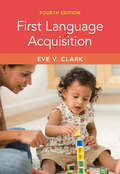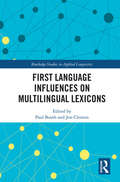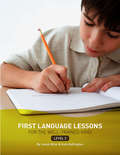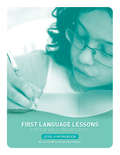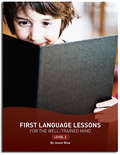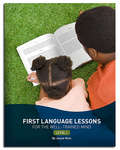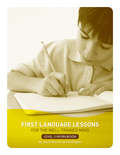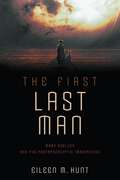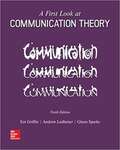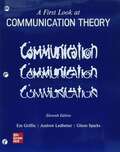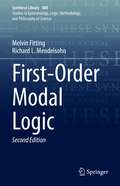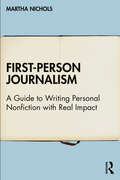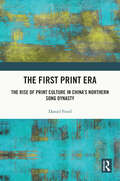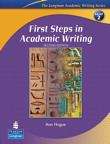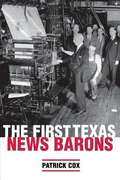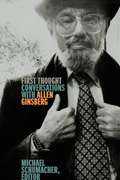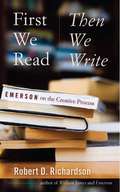- Table View
- List View
First Language Acquisition
by Eve V. ClarkNow in its fourth edition, this textbook provides a chronological account of first language acquisition, showing how young children acquire language in their conversational interactions with adult speakers. It draws on diary records and experimental studies from leaders in the field to document different stages and different aspects of what children master. Successive chapters detail infants' and young children's progression from attending to adult faces, gaze, and hand motions, to their first attempts at communicating with gaze and gesture, then adding words and constructions. It comprehensively covers the acquisition of the core areas of language – phonetics and phonology, lexicon, grammar and sentence structure, and meaning – as well as how children acquire discourse and conversational skills. This edition includes new sections on how children build 'common ground' with adults and other children, individual differences in children's language development, how they collaborate with adults in constructing utterances, and how they qualify beliefs.
First Language Acquisition
by Clark Eve V.How do young children learn language? When does this process start? What does language acquisition involve? Children are exposed to language from birth, surrounded by knowledgeable speakers who offer feedback and provide extensive practice every day. Through conversation and joint activities, children master the language being used around them. This fully revised third edition of Eve V. Clark's bestselling textbook offers comprehensive coverage of language acquisition, from a baby's first sounds to a child's increasing skill in negotiating, explaining and entertaining with language. This book, drawing together the most recent findings in the field, and illustrated with examples from a wide range of experimental and observational studies, including the author's own diary observations, presents an essential and comprehensive guide to first language acquisition. It will be fascinating reading for students of linguistics, developmental psychology, and cognitive science.
First Language Influences on Multilingual Lexicons (Routledge Studies in Applied Linguistics)
by Paul Booth Jon ClentonThis collection brings together recent research on the influences between first and additional languages with a focus on the development of multilingual lexicons. Featuring work from an international group of scholars, the volume examines the complex dynamics underpinning vocabulary in second and third languages and the role first languages play within this process. The book is organized around three different facets of research in this area – lexical recognition, processing, and knowledge; the effects of first languages on second language reading and writing, collocations, and translation skills; and, vocabulary testing – drawing on examples from a variety of languages, including European languages, Arabic, and Japanese. Setting the stage for further research on the interplay between first languages and multilingual lexicons, this volume is key reading for students and researchers in applied linguistics, language learning and teaching, bilingualism, second language acquisition, and translation studies.
First Language Lessons for the Well-Trained Mind: Level 3 Instructor Guide (First Language Lessons)
by Sara Buffington Jessie WiseThe third volume in the First Language Lessons series, this scripted guide uses the classical techniques of memorization, copywork, dictation, and narration to develop your child's language ability in the formative first years of study. The Level 3 Instructor Guide for First Language Lessons for the Well-Trained Mind reinforces the grammar and writing concepts introduced in the previous levels. It also introduces new material, including sentence diagramming. This instructor book has the same simple-to-use, scripted format as the previous levels. (The Level 3 Student Workbook is available separately; the workbook makes it easier for busy parents to spend more time teaching, and less time preparing--you don't have to hand-draw any diagram frames!) First Language Lessons Level 3 is designed to follow Levels 1 and 2, but can be used as a first grammar text for older students. The optional end-units on writing letters, dictionary skills, and oral usage allow you to tailor the instruction to the needs of your child. Grade Recommendation: Grades 2-4.
First Language Lessons for the Well-Trained Mind: Level 4 Instructor Guide (First Language Lessons)
by Sara Buffington Jessie WiseA simple-to-use, scripted guide to grammar and composition that makes successful teaching easy--for both parents and students. This volume, the Level 4 Instructor Guide in the complete elementary grammar series, uses classical techniques of memorization, dictation, and narration to develop your child's language ability in the important, foundational years of language study. The text covers a full range of grammar topics, including parts of speech, punctuation, sentence diagrams, and skills in beginning writing and storytelling. Optional end units provide practice in dictionary use and letter writing. Designed to follow Levels 1-3, the Level 4 Instructor Guide can also be used as a first grammar text for older students. A Level 4 Student Workbook is available separately with worksheet and activities. Grade Recommendation: Grades 4-5.
First Language Lessons for the Well-Trained Mind: Level 4 Student Workbook (First Language Lessons)
by Sara Buffington Jessie WiseA simple-to-use, scripted workbook to grammar and composition that accompanies the First Language Lessons for the Well-Trained Mind, Level 4 textbook and makes successful teaching easy--for both parents and students. This workbook, accompanying the Level 4 Instructor Guide (available separately) in the First Language Lessons complete elementary grammar series, uses classical techniques of memorization, dictation, and narration to develop your child's language ability in the important, foundational years of language study. This Level 4 Student Workbook provides complete worksheets for the student, making it possible for busy parents and teachers to spend more time teaching and less time preparing. Grade Recommendation: Grades 4-5.
First Language Lessons for the Well-Trained Mind: Level 2 (Second Edition) (First Language Lessons)
by Jessie WiseA complete beginning grammar text that uses copywork, narration, picture study, and other classical techniques to develop the young student's language ability. Scripted lessons give the teacher direction and confidence, while exquisite pencil reproductions of great paintings are used to encourage children in oral composition. Originally published as a single two-year volume, Level 2 (Grade 2, this book) and Level 1 (Grade 1, available separately) have been redesigned as two separate simple-to-use one-year programs. Grade Recommendation: Grade 2.
First Language Lessons for the Well-Trained Mind: Level 1 (Second Edition) (First Language Lessons) (First Language Lessons #0)
by Jessie WiseA complete beginning grammar text that uses copywork, narration, picture study, and other classical techniques to develop the young student's language ability. Scripted lessons give the teacher direction and confidence, while exquisite pencil reproductions of great paintings are used to encourage children in oral composition. Originally published as a single two-year volume, Level 1 (Grade 1, this book) and Level 2 (Grade 2, available separately) have been redesigned as two separate simple-to-use one-year programs. Grade Recommendation: Grade 1.
First Language Lessons for the Well-Trained Mind: Level 3 Student Workbook (First Language Lessons)
by Jessie Wise Sara BuffingtonFirst Language Lessons is a simple-to-use, scripted guide to grammar and composition that makes successful teaching simple--for both parents and teachers. The Level 3 Student Workbook (Grades 2-4) for First Language Lessons, used alongside the teacher's Level 3 Instructor Guide, gives teachers everything they need to spend more time teaching their students--and less time preparing lessons, making copies, or gathering supplies. It's all right here: inside this book, you'll find poems for memorization, empty sentence diagram frames, and blank lines perfectly sized for young students' copywork, dictation, and narration. First Language Lessons, Level 3 is a complete grammar and writing text that covers a wide range of topics--including parts of speech, sentence diagrams, and skills in beginning writing, storytelling, and narration. This Level 3 Student Workbook is the perfect complement to the lessons. Grade Recommendation: Grades 2-4.
The First Last Man: Mary Shelley and the Postapocalyptic Imagination
by Eileen M. HuntBeyond her most famous creation—the nightmarish vision of Frankenstein’s Creature—Mary Shelley’s most enduring influence on politics, literature, and art perhaps stems from the legacy of her lesser-known novel about the near-extinction of the human species through war, disease, and corruption. This novel, The Last Man (1826), gives us the iconic image of a heroic survivor who narrates the history of an apocalyptic disaster in order to save humanity—if not as a species, then at least as the practice of compassion or humaneness. In visual and musical arts from 1826 to the present, this postapocalyptic figure has transmogrified from the “last man” into the globally familiar filmic images of the “invisible man” and the “final girl.”Reading Shelley’s work against the background of epidemic literature and political thought from ancient Greece to Covid-19, Eileen M. Hunt reveals how Shelley’s postapocalyptic imagination has shaped science fiction and dystopian writing from H. G. Wells, M. P. Shiel, and George Orwell to Octavia Butler, Margaret Atwood, and Emily St. John Mandel. Through archival research into Shelley’s personal journals and other writings, Hunt unearths Shelley’s ruminations on her own personal experiences of loss, including the death of young children in her family to disease and the drowning of her husband, Percy Bysshe Shelley. Shelley’s grief drove her to intensive study of Greek tragedy, through which she developed the thinking about plague, conflict, and collective responsibility that later emerges in her fiction. From her readings of classic works of plague literature to her own translation of Sophocles’s Oedipus Rex, and from her authorship of the first major modern pandemic novel to her continued influence on contemporary popular culture, Shelley gave rise to a tradition of postapocalyptic thought that asks a question that the Covid-19 pandemic has made newly urgent for many: What do humans do after disaster?
A First Look at Communication Theory
by Em Griffin Andrew Ledbetter Glenn SparksThe tenth edition of A First Look at Communication Theory justifies again the program's enduring popularity. EM Griffin, now joined by colleagues Andrew Ledbetter and Glenn Sparks, encourages students who are encountering the field for the first time to tackle theories without fear. <p><p> The text's conversational style and relevant examples keep complex theories within the grasp of first-time theory students. The authors introduce 32 diverse theories that are a mix of foundational and recent scholarship and, with the benefit of numerous examples and connections to pop culture, help students apply them to their own lives. The discrete presentation of the theories ensures a well-rounded understanding of each while promoting integrative thinking and facilitating the ability of instructors to skip or rearrange their presentation. <p><p> The broad selection of theories-from the classics to the cutting edge-ensures that students have a solid foundation with which to begin understanding the relationships between theories.
A First Look At Communication Theory
by Emory A. Griffin Andrew Ledbetter Glenn Grayson SparksThe 11th edition of A First Look at Communication Theory encourages students who are encountering the field for the first time to tackle theories without fear. The authors’ conversational style and relevant examples keep complex theories within the grasp of first-time theory students. They introduce over 30 diverse theories that are a mix of foundational and recent scholarship and, with the benefit of numerous examples and connections to pop culture, help students apply them to their own lives. The discrete presentation of the theories ensures a well-rounded understanding of each while promoting integrative thinking and facilitating the ability of instructors to skip or rearrange their presentation. The broad selection of theories-from the classics to the cutting edge-ensures that students have a solid foundation with which to begin understanding the relationships between theories.
A First Look at Communication Theory (Ninth Edition)
by Em Griffin Andrew Ledbetter Glenn SparksThe ninth edition of A First Look at Communication Theory justifies again the program's enduring popularity. Em Griffin, now joined by colleagues Andrew Ledbetter and Glenn Sparks, encourages students who are encountering the field for the first time to tackle theories without fear. The authors introduce 32 diverse theories that are a mix of foundational and recent scholarship and, with the benefit of numerous examples and connections to pop culture, help students apply them to their own lives. This program ensures that students have a solid foundation with which to begin understanding the relationships between theories.
The First Modern Japanese: The Life of Ishikawa Takuboku (Asia Perspectives: History, Society, and Culture)
by Donald KeeneMany books in Japanese have been devoted to the poet and critic Ishikawa Takuboku (1886–1912). Although he died at the age of twenty-six and wrote many of his best-known poems in the space of a few years, his name is familiar to every literate Japanese. Takuboku's early death added to the sad romance of the unhappy poet, but there has been no satisfactory biography of his life or career, even in Japanese, and only a small part of his writings have been translated. His mature poetry was based on the work of no predecessor, and he left no disciples. Takuboku stands unique.Takuboku's most popular poems, especially those with a humorous overlay, are often read and memorized, but his diaries and letters, though less familiar, contain rich and vivid glimpses of the poet's thoughts and experiences. They reflect the outlook of an unconstrained man who at times behaved in a startling or even shocking manner. Despite his misdemeanors, Takuboku is regarded as a national poet, all but a saint to his admirers, especially in the regions of Japan where he lived. His refusal to conform to the Japan of the time drove him in striking directions and ranked him as the first poet of the new Japan.
First-Order Modal Logic (Synthese Library #480)
by Melvin Fitting Richard L. MendelsohnThis is a thorough treatment of first-order modal logic. The book covers such issues as quantification, equality (including a treatment of Frege's morning star/evening star puzzle), the notion of existence, non-rigid constants and function symbols, predicate abstraction, the distinction between nonexistence and nondesignation, and definite descriptions, borrowing from both Fregean and Russellian paradigms.
First-Person Anonymous: Women Writers and Victorian Print Media, 1830–1870 (The Nineteenth Century Series)
by Alexis EasleyFirst-Person Anonymous revises previous histories of Victorian women's writing by examining the importance of both anonymous periodical journalism and signed book authorship in women’s literary careers. Alexis Easley demonstrates how women writers capitalized on the publishing conventions associated with signed and unsigned print media in order to create their own spaces of agency and meaning within a male-dominated publishing industry. She highlights the importance of journalism in the fashioning of women's complex identities, thus providing a counterpoint to conventional critical accounts of the period that reduce periodical journalism to a monolithically oppressive domain of power relations. Instead, she demonstrates how anonymous publication enabled women to participate in important social and political debates without compromising their middle-class respectability. Through extensive analysis of literary and journalistic texts, Easley demonstrates how the narrative strategies and political concerns associated with women's journalism carried over into their signed books of poetry and prose. Women faced a variety of obstacles and opportunities as they negotiated the demands of signed and unsigned print media. In investigating women's engagement with these media, Easley focuses specifically on the work of Christian Johnstone (1781-1857), Harriet Martineau (1802-76), Elizabeth Gaskell (1810-65), George Eliot (1819-80) , and Christina Rossetti (1830-94). She provides new insight into the careers of these authors and recovers a large, anonymous body of periodical writing through which their better known careers emerged into public visibility. Since her work touches on two issues central to the study of literary history - the construction of the author and changes in media technology - it will appeal to an audience of scholars and general readers in the fields of Victorian literature, media studies, periodicals research, gender studies, and nineteenth-century
First-Person Journalism: A Guide to Writing Personal Nonfiction with Real Impact
by Martha NicholsA first-of-its-kind guide for new media times, this book provides practical, step-by-step instructions for writing first-person features, essays, and digital content. Combining journalism techniques with self-exploration and personal storytelling, First-Person Journalism is designed to help writers to develop their personal voice and establish a narrative stance. The book introduces nine elements of first-person journalism—passion, self-reporting, stance, observation, attribution, counterpoints, time travel, the mix, and impact. Two introductory chapters define first-person journalism and its value in building trust with a public now skeptical of traditional news media. The nine practice chapters that follow each focus on one first-person element, presenting a sequence of "voice lessons" with a culminating writing assignment, such as a personal trend story or an open letter. Examples are drawn from diverse nonfiction writers and journalists, including Ta-Nehisi Coates, Joan Didion, Helen Garner, Alex Tizon, and James Baldwin. Together, the book provides a fresh look at the craft of nonfiction, offering much-needed advice on writing with style, authority, and a unique point of view. Written with a knowledge of the rapidly changing digital media environment, First-Person Journalism is a key text for journalism and media students interested in personal nonfiction, as well as for early-career nonfiction writers looking to develop this narrative form.
The First Print Era: The Rise of Print Culture in China’s Northern Song Dynasty
by Daniel FriedThe First Print Era examines the rise of print culture during China’s Northern Song Dynasty (960–1127). Bringing together often-overlooked primary sources from the period and scholarship on many individual topics in Song print history, the book offers the first extended narrative in English of how print became entrenched as a sustained mode of textual dissemination in China. While discussing technical innovations and the growth of the print industry, the book focuses on how the rise of print affected several indispensable elements of Song intellectual culture: the expansion of the exam system, the canonization of Tang and earlier models, the rise of antiquarianism and connoisseurship, the birth of Neo-Confucianism as a new intellectual force, the growth of a new literati culture and new forms of literary production and critique, and the development of calligraphy as an art form that could be taught, critiqued, and divided into schools. Overall, the book describes a process by which print publication moved from a highly centralized state enterprise, back to expanded elite use, and eventually towards the popular print markets that would create new forms of expression during the Southern Song and Yuan dynasties. This book will be an essential read for students and scholars of Asian studies, Medieval studies, and those with a focus on print history and Chinese studies.
First Readers of Shakespeare’s Sonnets, 1590-1790 (Routledge Studies in Shakespeare)
by Faith D. AckerFor more than four centuries, cultural preferences, literary values, critical contexts, and personal tastes have governed readers’ responses to Shakespeare’s sonnets. Early private readers often considered these poems in light of the religious, political, and humanist values by which they lived. Other seventeenth- and eighteenth- century readers, such as stationers and editors, balanced their personal literary preferences against the imagined or actual interests of the literate public to whom they marketed carefully curated editions of the sonnets, often successfully. Whether public or private, however, many disparate sonnet interpretations from the sonnets’ first two centuries in print have been overlooked by modern sonnet scholarship, with its emphasis on narrative and amorous readings of the 1609 sequence. First Readers of Shakespeare’s Sonnets reintroduces many early readings of Shakespeare’s sonnets, arguing that studying the priorities and interpretations of these previous readers expands the modern critical applications of these poems, thereby affording them numerous future applications. This volume draws upon book history, manuscript studies, and editorial theory to recover four lost critical approaches to the sonnets, highlighting early readers’ interests in Shakespeare’s classical adaptations, political applicability, religious themes, and rhetorical skill during the seventeenth and eighteenth centuries.
First Steps In Academic Writing
by Ann HogueThe second edition of First Steps in Academic Writing , by Ann Hogue, provides high-beginning to low-intermediate students with essential tools to master basic academic writing. The text's time-proven approach integrates paragraph organization, sentence structure, grammar, mechanics, and the writing process. First Steps leads students to build strong academic writing skills that will last them throughout their writing careers.
The First Ten Pages (How to Adapt Your Novel Into a Screenplay #4)
by Frank CatalanoHOW TO HAVE A STRONG OPENING FOR YOUR SCREENPLAY SO THEY WILL READ IT TO THE END. THE FIRST TEN PAGES was first presented as part of the 25th Annual Writer's Conference sponsored by San Diego State University on February 6 through the 8th, 2009 at the Double Tree Hilton Hotel in Mission Hills, California. The following transcript was presented and recorded by Frank Catalano as part of the programs offered at the conference. The book ibased partly upon that presentation, focuses on the adaptation of an existing novel into a screenplay for presentation as a motion picture, television program or Internet content. Writers of fiction and non-fiction and industry professionals from the publishing business primarily attended the 25th Annual Writer's Conference. Mr. Catalano's seminars focused upon those writers seeking to adapt their novels into screenplays. The complete list of seminar presentations by Frank Catalano for this conference is: BOOK 1: WRITE GREAT CHARACTERS IN THE FIRST TEN PAGES BOOK 2: WRITING ON YOUR FEET - IMPROVISATIONAL TECHNIQUES FOR WRITERS - Part 1 BOOK 3: START YOUR STORY AT THE END BOOK 4: THE FIRST TEN PAGES BOOK 5: BOOK TO SCREEN BOOK 6: ACTING IT OUT - IMPROVISATIONAL TECHNIQUES FOR WRITERS - Part 2 BOOK 7: WRITE GREAT DIALOGUE
The First Texas News Barons
by Patrick Cox"Those interested in how power is used& #151as well as who gets to wield it-- will enjoy this contribution to the study of journalism, often called the rough draft of history. " -- East Texas Historical Association Newspaper publishers played a crucial role in transforming Texas into a modern state. By promoting expanded industrialization and urbanization, as well as a more modern image of Texas as a southwestern, rather than southern, state, news barons in the early decades of the twentieth century laid the groundwork for the enormous economic growth and social changes that followed World War II. Yet their contribution to the modernization of Texas is largely unrecognized. This book investigates how newspaper owners such as A. H. Belo and George B. Dealey of the Dallas Morning News, Edwin Kiest of the Dallas Times Herald, William P. Hobby and Oveta Culp Hobby of the Houston Post, Jesse H. Jones and Marcellus Foster of the Houston Chronicle, and Amon G. Carter Sr. of the Fort Worth Star-Telegram paved the way for the modern state of Texas. Patrick Cox explores how these news barons identified the needs of the state and set out to attract the private investors and public funding that would boost the state's civic and military infrastructure, oil and gas industries, real estate market, and agricultural production. He shows how newspaper owners used events such as the Texas Centennial to promote tourism and create a uniquely Texan identity for the state. To balance the record, Cox also demonstrates that the news barons downplayed the interests of significant groups of Texans, including minorities, the poor and underemployed, union members, and a majority of women.
First Thought: Conversations with Allen Ginsberg
by Michael Schumacher&“The way to point to the existence of the universe is to see one thing directly and clearly and describe it. . . . If you see something as a symbol of something else, then you don't experience the object itself, but you're always referring it to something else in your mind. It's like making out with one person and thinking about another.&” —Ginsberg speaking to his writing class at Naropa Institute, 1985With &“Howl&” Allen Ginsberg became the voice of the Beat Generation. It was a voice heard in some of the best-known poetry of our time—but also in Ginsberg&’s eloquent and extensive commentary on literature, consciousness, and politics, as well as his own work. Much of what he had to say, he said in interviews, and many of the best of these are collected for the first time in this book. Here we encounter Ginsberg elaborating on how speech, as much as writing and reading, and even poetry, is an act of art.Testifying before a Senate subcommittee on LSD in 1966; gently pressing an emotionally broken Ezra Pound in a Venice pensione in 1967; taking questions in a U.C. Davis dormitory lobby after a visit to Vacaville State Prison in 1974; speaking at length on poetics, and in detail about his &“Blake Visions,&” with his father Louis (also a poet); engaging William Burroughs and Norman Mailer during a writing class: Ginsberg speaks with remarkable candor, insight, and erudition about reading and writing, music and fame, literary friendships and influences, and, of course, the culture (or counterculture) and politics of his generation. Revealing, enlightening, and often just plain entertaining, Allen Ginsberg in conversation is the quintessential twentieth-century American poet as we have never before encountered him: fully present, in pitch-perfect detail.
First We Read, Then We Write: Emerson on the Creative Process
by Robert D. Richardson[From the dust jacket:] "Writing was the central passion of Emerson's life. While his thoughts on the craft are well developed in "The Poet," "The American Scholar,"Nature, "Goethe," and "Persian Poetry," less well known are the many pages in his private journals devoted to the relationship between writing and reading. Here, for the first time, is the Concord Sage's energetic, exuberant, and unconventional advice on the idea of writing, focused and distilled by the preeminent Emerson biographer at work today. Emerson advised that "the way to write is to throw your body at the mark when your arrows are spent. "First We Read, Then We Writecontains numerous such surprises-from "every word we speak is million-faced" to "talent alone cannot make a writer"-but it is no mere collection of aphorisms and exhortations. Instead, in Robert Richardson's hands, the biographical and historical context in which Emerson worked becomes clear. Emerson's advice grew from his personal experience; in practically every moment of his adult life he was either preparing to write, trying to write, or writing. Richardson shows us an Emerson who is no granite bust but instead is a fully fleshed, creative person disarmingly willing to confront his own failures. Emerson urges his readers to try anything-strategies, tricks, makeshifts-speaking not only of the nuts and bolts of writing but also of the grain and sinew of his determination. Whether a writer by trade or a novice, every reader will find something to treasure in this volume. Fearlessly wrestling with "the birthing stage of art," Emerson's counsel on being a reader and writer will be read and reread for years to come."
